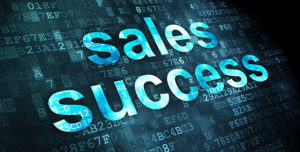Now is the time when growth-minded organizations and their sales leaders begin to evaluate this year while looking ahead to the next. It’s a time to identify opportunities for improvement, anticipate industry changes, and solidify a sales strategy that will align with the evolving expectations of business-to-business buyers, emerging technologies, and the company’s business goals.
Read on to discover what you can expect in 2020 on topics like the sales development rep role, decision-making around tech adoption and implementation, sales leaders as online influencers, and more.
The Changing SDR Role: Real or Robot?
Prediction No. 1: In 2020, look for AI to increasingly help augment sales teams but not replace them.
2020 is not the year of the robot. While we’ve let artificial intelligence infiltrate many areas of our personal lives via smart home assistants that tell us when to wake up, workout and buy milk, it hasn’t quite made its mark on the B2B sales organization yet.
By 2020, 30 percent of all B2B companies will employ artificial intelligence to augment at least one of their primary sales processes, according to Gartner. This means an overwhelming majority of sales orgs are not yet on board.
AI is just starting to realize its promise of improving sales organizations through increases in efficiency, reduction of costs, and improved revenue streams.
We’ve made a great deal of progress since I first started in sales, and technology has been the biggest driver of that progress. I know the rate of iteration increases forever, but we still have a long way to go before the average company would trust its brand and reputation to full automation.
Why? Because technology — as it stands today — cannot replace a human connection. While AI may be faster and in many cases smarter, it can’t pick up the phone and build rapport, and most of the time it can’t close a high-ticket sale. We still need people for that.
Tech Stack Continues to Grow
Prediction No. 2: In 2020, the tech stack will continue to grow, rather than shrink, as long as efficiency follows.
In 2020, I see less focus on the “cost” of sales tech and more emphasis on the return on investment or outcome.
The average annual spend on sales technology was US$4,581 per rep per year and spans an average of 5.2 categories of sales tools per rep, according to InsideSales. The top categories of sales tools include CRM, social prospecting, presentations, pipeline management, and data/list services. New sales tools launch every day, it seems, with promises to increase sales productivity, leads or closes.
While cost always will be a factor, what really counts is that these tools help enable sales reps to make touches faster and spend more time focusing on strategic, relationship-based sales activities. We’re starting to have more respect for the multiplier effect or efficiency gains you can get from these tools.
A New Generation of Tech Buyers Has Emerged
Prediction No. 3: In 2020, if brands don’t make a significant change in how they do business with millennials, they’ll surely fall behind.
Millennials — now in the 23-38 age range — make up more than a third of the workforce.
Members of this generation are commonly involved in making Software-as-a-service purchasing decisions.
More than 45 percent of the 430 B2B technology buyers TrustRadius surveyed for its B2B Buying Disconnect research study were millennials — the most of any age group looking into B2B products and services.
I know that some brand teams today are designing content and messaging specifically for the “new” generation of technology buyers, but for me it’s more an overall shift in the way we do business in the sales industry. I can’t imagine the older generations in my family doing business the way modern sales teams do now.
The entire dynamic has changed, and I think that makes it really easy for us to fail to realize this messaging/tactics shift has already begun in earnest.
Case in point: “Vendors who were very influential during the purchasing process were twice as likely to be open about product limitations and connect buyers with current customers,” the TrustRadius report found. This is a fundamental shift away from how most of us are used to selling.
Sales Leaders to Make Their Brand Personal
Prediction No. 4: In 2020, if your No. 1 delivery method is still just standing up on that soapbox and screaming your message, you’re missing the mark and the ideal opportunity for brand building.
In 2020, successful sales leaders are sales influencers. The way humans interact with and consume information has changed. We’re mobile, always connected, and using technology to share and ingest massive amounts of data.
It may be a cliche, but the fact is people buy from those they know, like, and trust. Today, the best way to get to know, like, and trust someone is by consuming their content online.
Look at sales Influencers like John Barrows, Max Altschuler, and Becc Holland.
They frequently post written, visual, and audio content to build their brand and expertise. I predict a rise in the trend of sales leadership following suit to further elevate their companies, as well as their personal brands.
Look for more sales leaders to write thought leadership articles, appear on podcasts, create videos, and find other interesting ways to share their ideas online, solidifying their subject matter expertise to their core audiences.
Agility Matters
The B2B sales industry is changing rapidly, thanks to emerging technologies, a growing tech stack, a new generation of B2B buyers, and changes in the way we consume data, build trust, and make purchasing decisions.
2020 is the beginning of a new decade, and sweeping changes lie ahead. Sales teams that adapt to evolving customer expectations, while leveraging tools and technology to increase productivity, will gain a competitive advantage over those that remain stuck in their ways.
















































